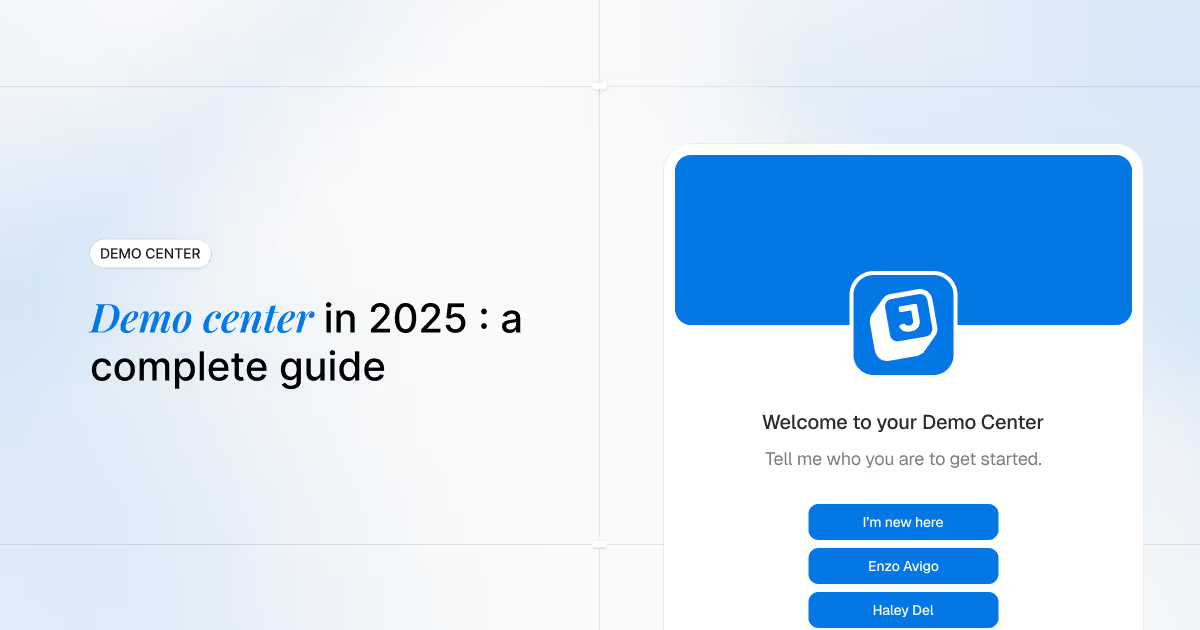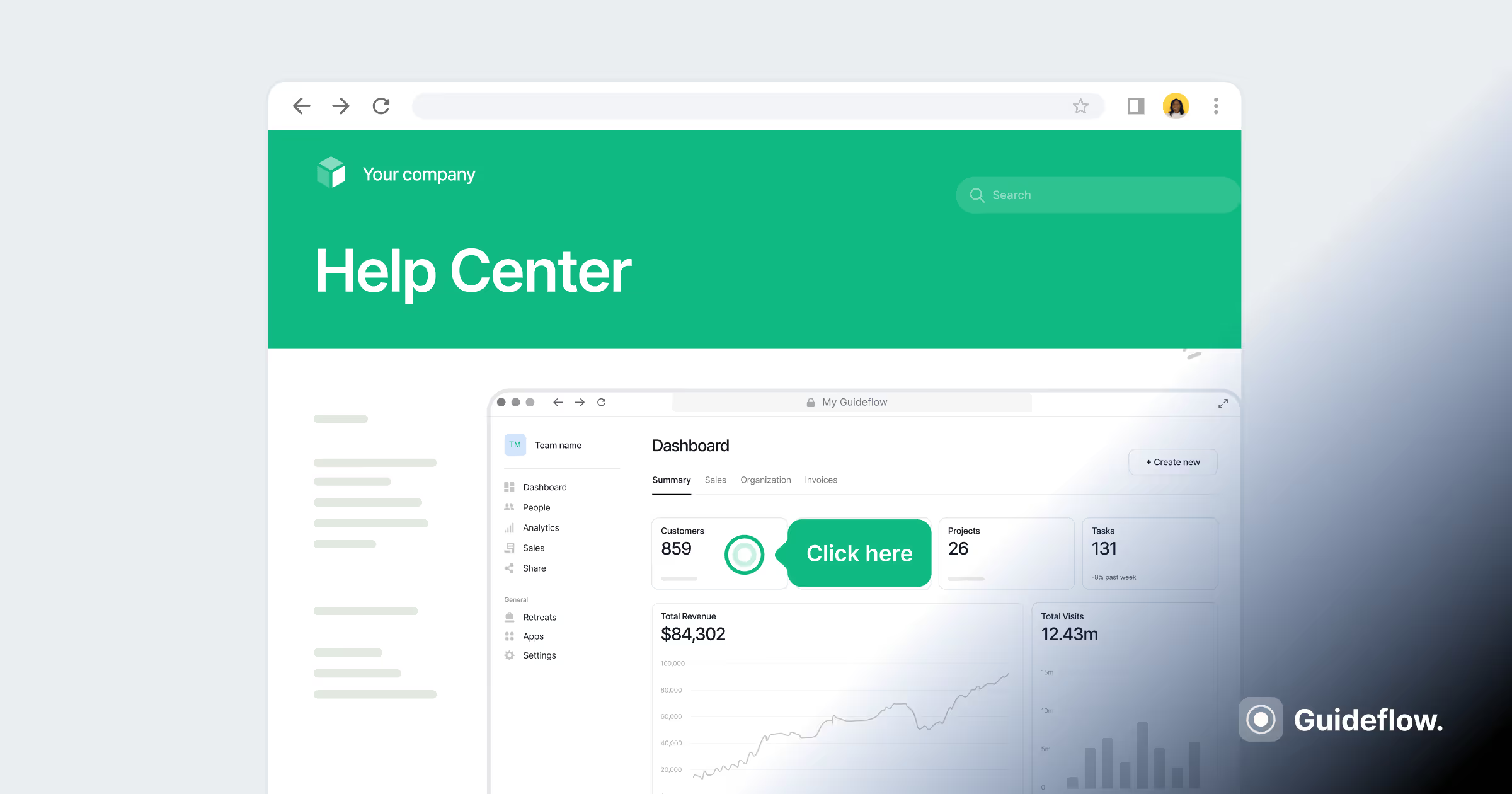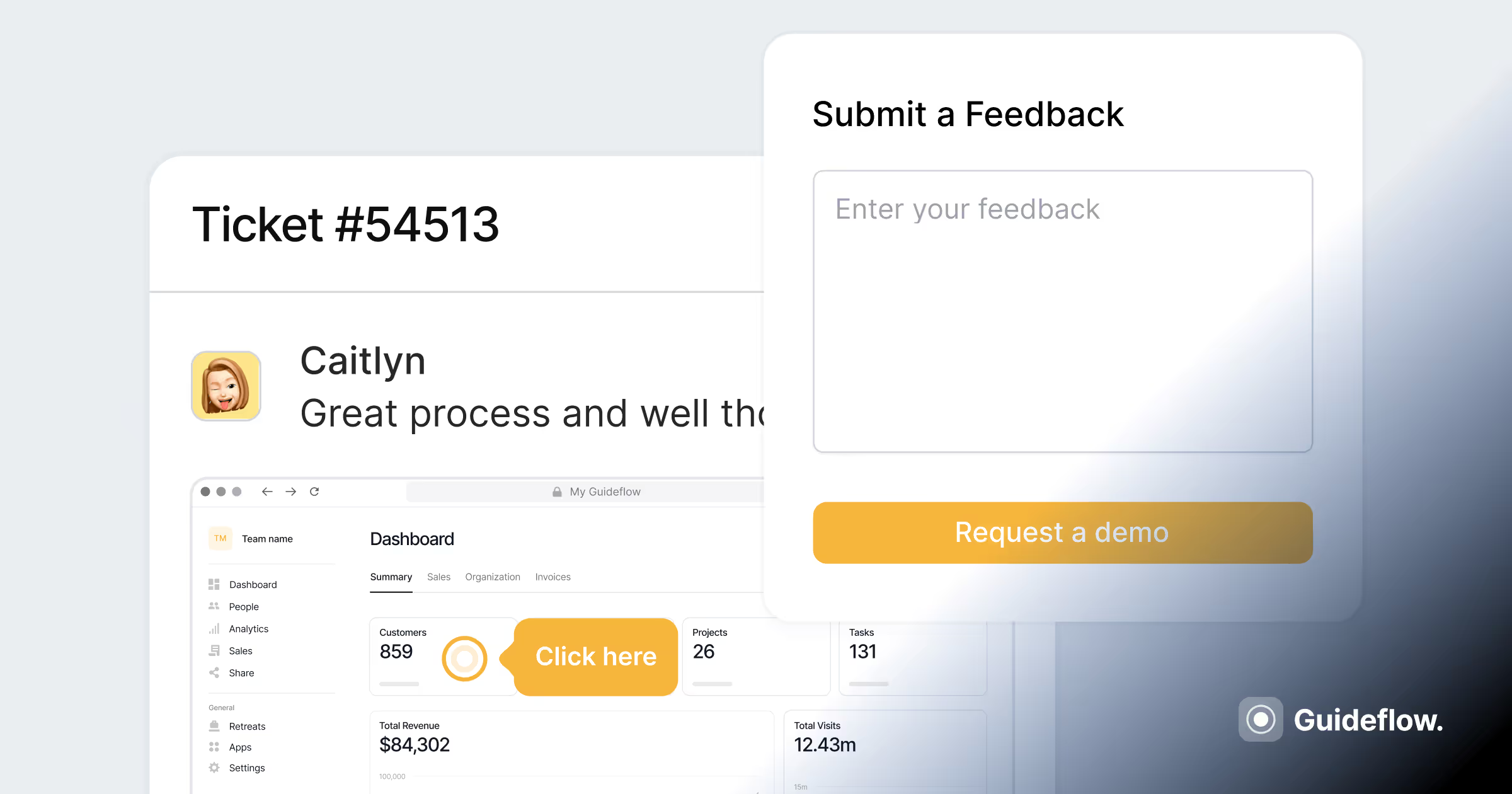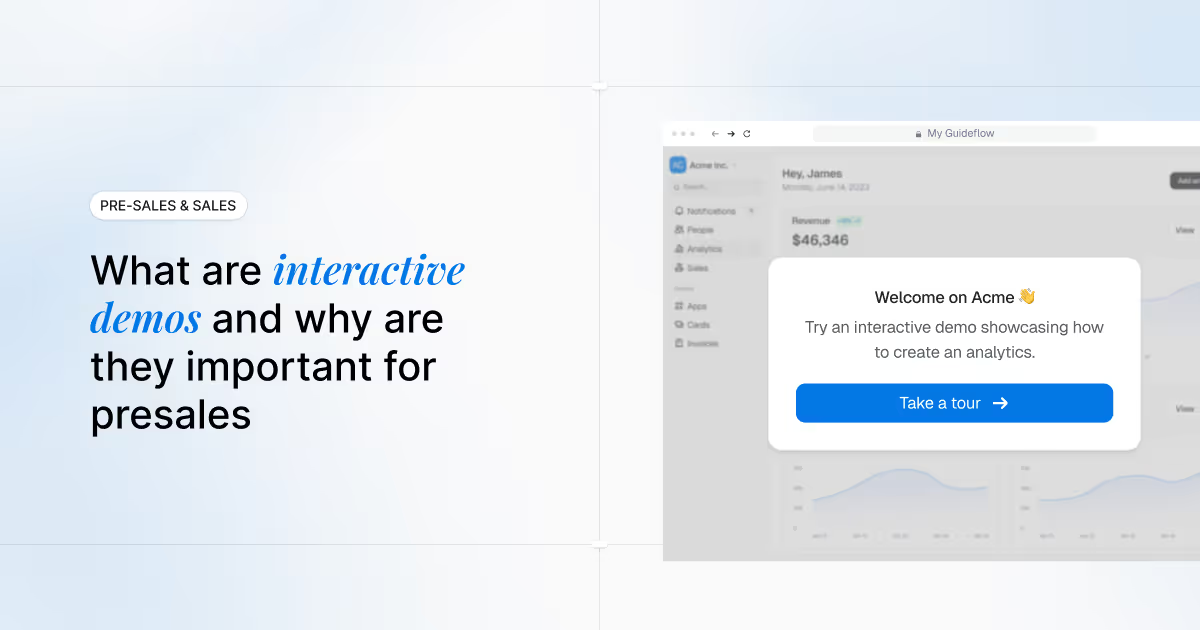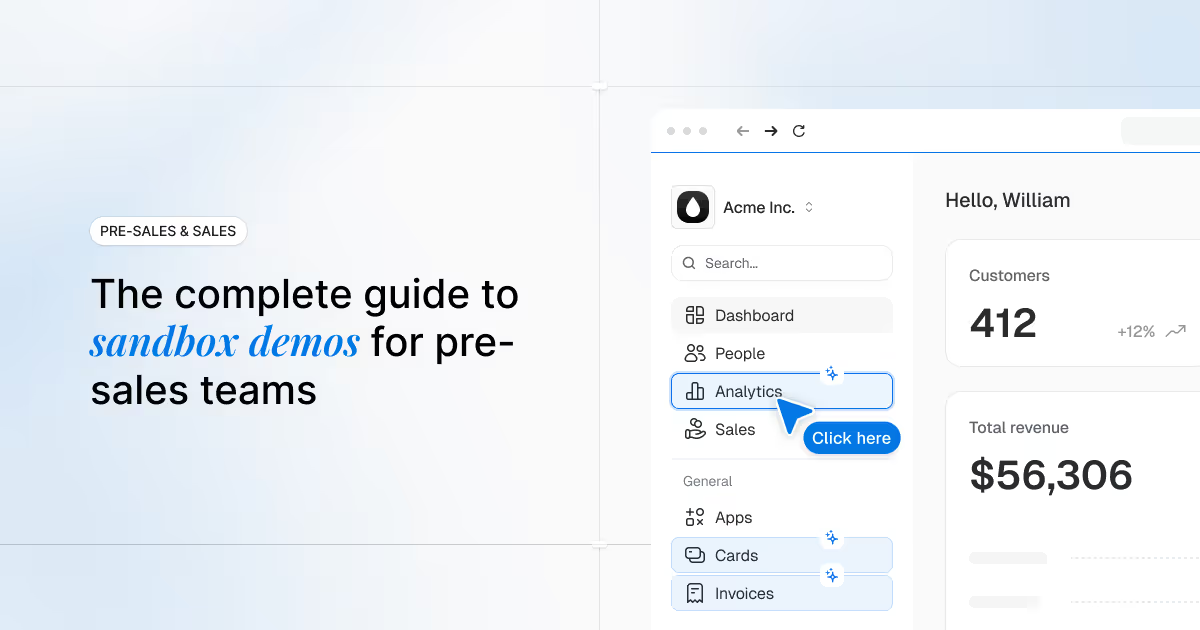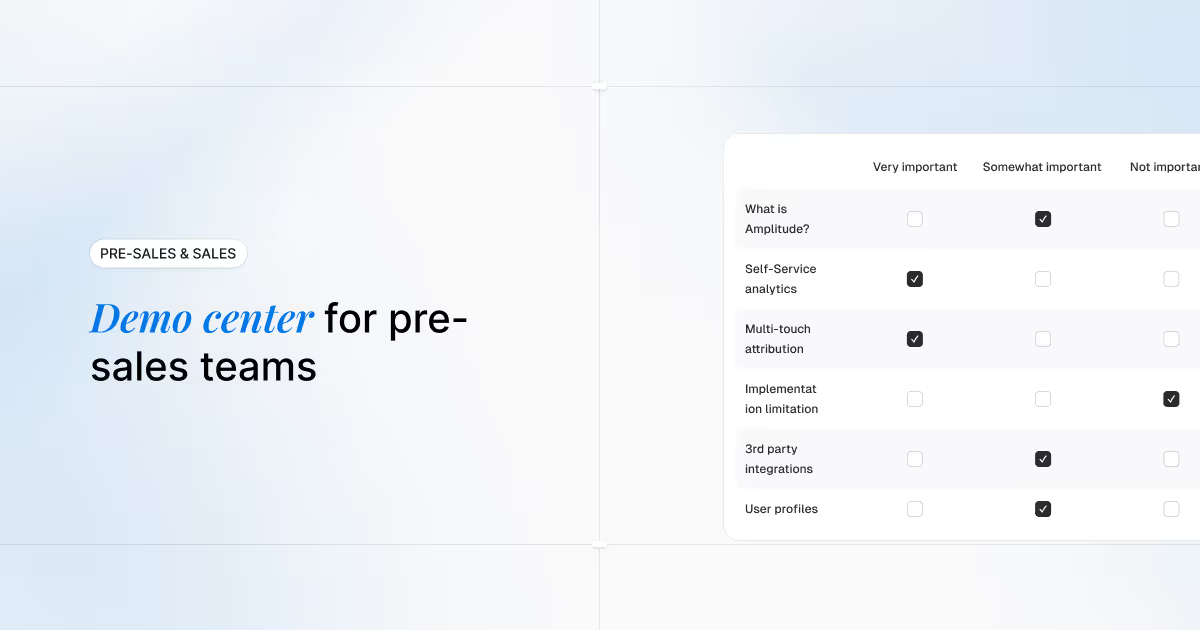Your buyers need more than one demo. Different stakeholders have different needs: marketing wants campaign impact, IT needs security details, CFO focuses on ROI, and end users care about the interface.
Most companies offer a single, generic demo that tries to please everyone but engages no one. When a CFO sits through technical integration details or end users endure enterprise security features, disengagement follows. With B2B buying committees including 6-12 stakeholders and 57% of buyers preferring self-education, generic demos fail to address specific concerns.
This approach costs deals. Stakeholders leave confused, sales teams burn out with repetitive presentations, and buying processes stall as decision-makers search for relevant information, resulting in longer sales cycles, lower conversions, and prospects turning to competitors.
Demo centers solve this by offering targeted user journeys aligned with how buyers evaluate solutions. Like a playlist of product demos and other content, stakeholders explore what matters most at their own pace. The results are compelling: companies using demo centers see 73% higher engagement while reducing sales burden and accelerating deals through better-qualified prospects.
What is a demo center?
A demo center is a centralized hub that combines product demos, videos, case studies, and other sales assets into one cohesive experience. It ties your product into a user journey that's tailored to each stakeholder, fast to create, and scalable for any organization. Demo centers can be customized for different personas, use cases, and buying stages through branching.
Their interactive nature allows for scenarios where users can choose different paths based on their interests. This way, prospects explore products through curated demo playlists organized by industry, role, or pain points. They can view product overviews, explore specific features, and access relevant case studies.
Key components of a modern demo center include
- Interactive product demonstrations with clickable interfaces
- Segmented content libraries by persona and use case
- Real-time visitor tracking capturing engagement patterns
- Smart lead qualification routing high-intent prospects
- CRM integration syncing visitor data with workflows
- Branded customization maintaining visual identity
- Advanced personalization engines adapting content to visitors
- Branching navigation allowing users to follow personalized paths
Demo center technology enables no-code personalization without requiring technical expertise. Platforms like Guideflow allow teams to build demo experiences using simple drag-and-drop editors and deploy them across multiple channels while tracking comprehensive analytics.
This approach solves content organization challenges by providing one authoritative source that updates across all distribution channels.
The modern buyer challenge
Today's B2B buyers expect immediate access to information, self-guided exploration, and multi-stakeholder involvement without constant salesperson coordination. This creates significant challenges throughout the buyer journey. During the discovery phase, generic landing pages with single demos fail to address specific use cases, leaving prospects without the targeted information they need. As buyers move into the evaluation stage, individual email attachments create inconsistent experiences that fragment the buying process. When reaching the decision process, content that isn't organized by audience needs makes it difficult for stakeholders to find relevant information.
Buyers prefer self-service exploration to compare features and build business cases before engaging sales, yet most companies offer linear demos that ignore these preferences. During enterprise software evaluations, various stakeholders bring different requirements—CMOs want strategic impact, operations managers need technical details, IT requires compliance documentation, and procurement seeks pricing information.
Traditional demo approaches create significant friction across multiple dimensions. Single videos can't address the diverse needs of multiple stakeholders, while email attachments create version control issues that lead to confusion. Individual demonstrations require complex scheduling that slows down the buying process, and generic content ignores industry-specific requirements that are critical for decision-making.
This approach frustrates prospects and challenges internal teams. Sales reps find themselves delivering repetitive demonstrations, marketing struggles to track engagement effectively, and customer success teams can't identify the most promising prospects. The cumulative effect leads to longer sales cycles, reduced conversion rates, and higher customer acquisition costs. Companies that fail to enhance their buyer experience ultimately put themselves at a competitive disadvantage in the market.
How demo centers work
Demo centers operate as centralized content platforms that combine content organization, visitor tracking, and personalization engines to create seamless self-serve buyer experiences.
The technical architecture includes
- Content management layer where teams organize demonstrations, videos, case studies, and sales collateral into logical categories supporting various content types from screen recordings to fully interactive product simulations
- Personalization engine that uses visitor data, CRM integration, and behavioral tracking to customize experiences automatically based on company characteristics and engagement patterns
- Analytics and tracking system that captures every interaction to generate data about visitor engagement patterns, content preferences, and intent signals that feed directly into lead scoring models
- Integration capabilities that connect with existing go-to-market technology stacks through APIs, flowing visitor data automatically into CRM systems while enabling marketing automation triggers based on specific demo interactions
The visitor experience flows naturally
Prospects arrive through various channels and encounter curated experiences matching their profile and interests. Smart routing technology identifies visitor characteristics through IP data, UTM parameters, or CRM integration, then presents relevant content automatically.
Navigation remains intuitive with clear categories and search functionality. Visitors browse content like a well-organized library, progressing from overview demonstrations to detailed feature walkthroughs or industry-specific use cases while the platform captures engagement data for qualification.
Key benefits for go-to-market teams
Sales team advantages
The modern sales motion transforms when prospects arrive already educated. Pre-qualification through demo centers fundamentally changes the sales conversation - instead of spending hours demonstrating basic functionality, sales teams engage in strategic discussions about specific business requirements. This shift isn't incremental; prospects who explore interactive demos before sales engagement complete deals significantly faster, having already built internal consensus around solution fit.
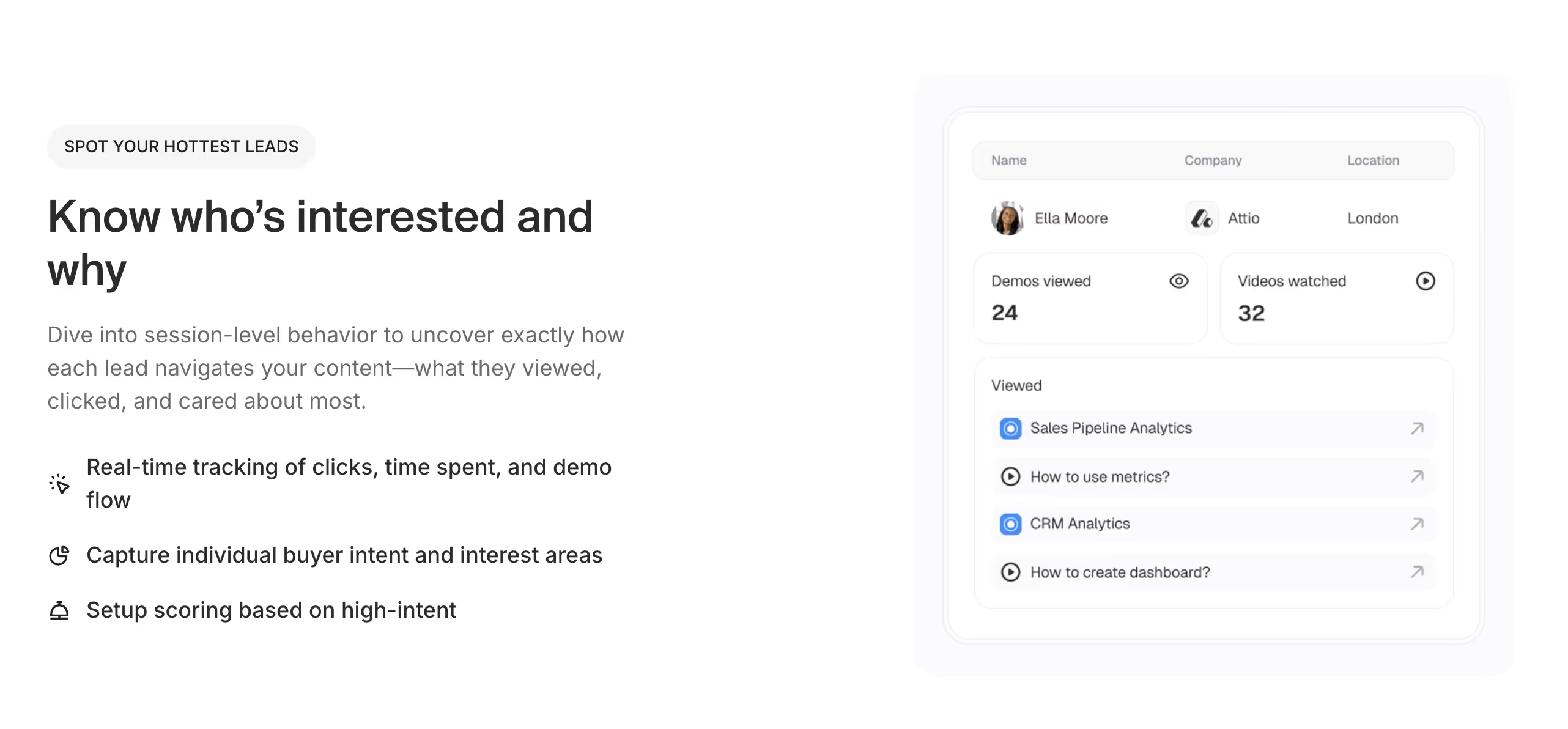
The impact compounds through intelligent lead scoring. Every click, every minute spent exploring specific features, and every return visit creates a rich intent profile that sales teams leverage to prioritize their pipeline. When a prospect books a meeting after spending 15 minutes in your pricing calculator and enterprise features demo, that conversation starts from an entirely different place than a cold inbound lead. Sales representatives report that demo-qualified leads ask deeper questions about implementation and ROI rather than "what does your product do?" - accelerating the entire deal cycle.
Marketing team benefits
Interactive demo experiences consistently deliver 2-3x higher engagement rates than static content, but the real transformation happens in lead quality. When prospects self-qualify through guided demo journeys, marketing teams capture not just contact information but genuine product-market fit signals. A visitor who completes multiple demo paths aligned with their use case represents a fundamentally different opportunity than someone who downloads a whitepaper.
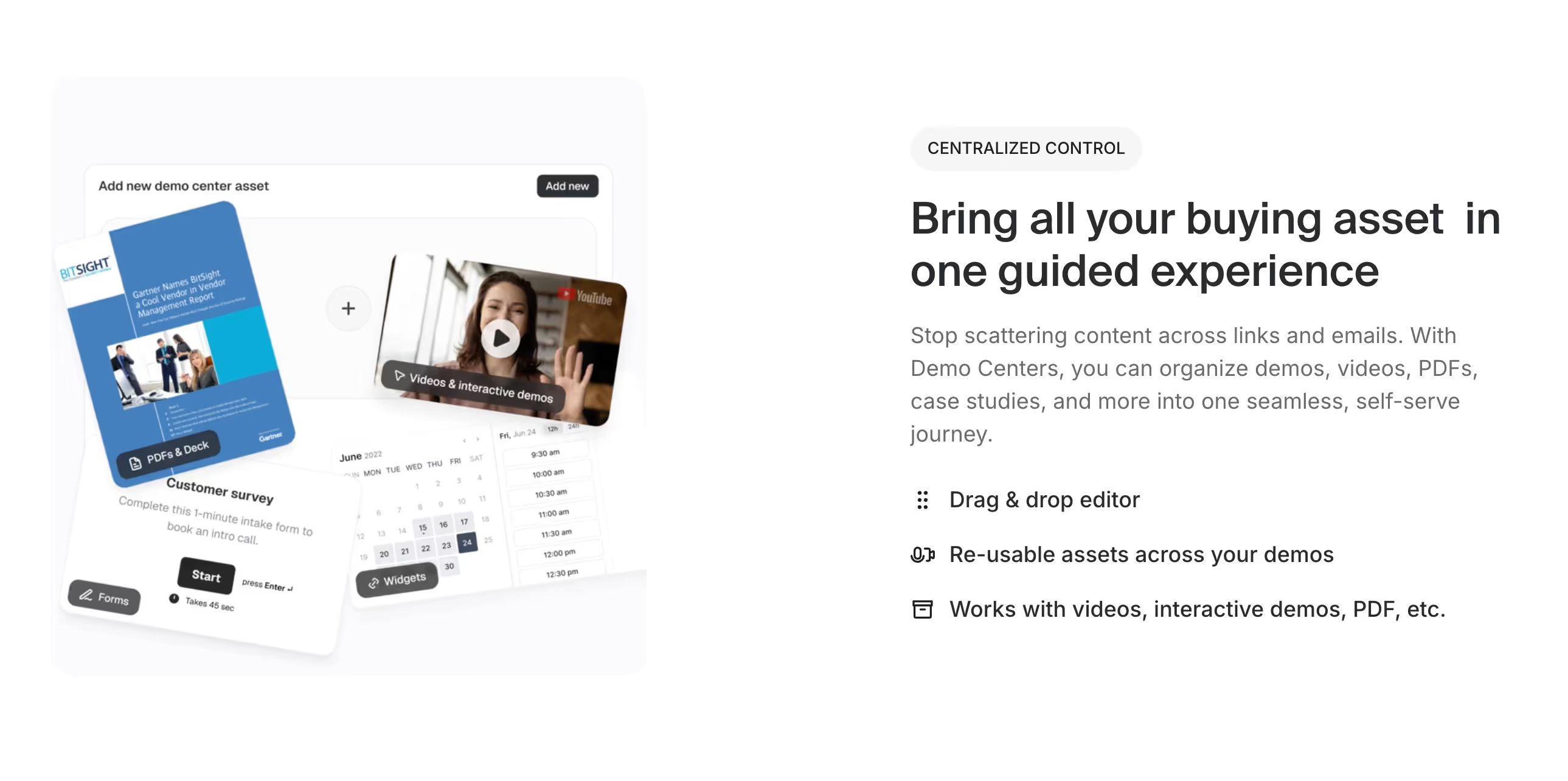
This behavioral data powers sophisticated nurture strategies that respond to actual product interest rather than assumed intent. Marketing teams orchestrate account-based campaigns triggered by specific demonstration patterns - when three stakeholders from the same company explore different feature sets, that's a buying committee forming in real-time. The centralized content management ensures every touchpoint reinforces consistent messaging while enabling instant updates across all demo experiences when products evolve or positioning shifts.
Customer success advantages
The relationship between customer success and demo centers extends far beyond onboarding. New customers who access comprehensive, self-guided product training reduce their time-to-value while freeing customer success managers to focus on strategic business outcomes rather than feature education. This shift from reactive support to proactive guidance fundamentally changes the customer relationship.
Feature adoption patterns visible through demo engagement reveal expansion opportunities before customers even ask. When an existing customer's team members start exploring advanced functionality or adjacent product demos, customer success identifies upsell potential through behavior rather than quarterly business reviews. The compound effect shows in support metrics -comprehensive self-service demonstration libraries answer common questions before tickets get created, while proper usage examples prevent issues from occurring. Teams report 30-40% reductions in repetitive support requests when customers can instantly access relevant product walkthroughs tailored to their specific use cases.
Real-world use cases
Use case 1: Landing page conversion optimization
Challenge
Most B2B landing pages rely on a single demo video or form to convert visitors, creating a fundamental mismatch between diverse visitor needs and monolithic content experiences. A CFO researching financial reporting capabilities sees the same content as a technical user evaluating API integrations. This one-size-fits-all approach fails to acknowledge that visitors arrive with different questions, priorities, and evaluation criteria based on their role, industry, and stage in the buying journey.
The result is predictable: high bounce rates, shallow engagement, and missed conversion opportunities at the exact moment prospects are most receptive. Traditional landing pages force visitors into a binary choice - watch this single demo or leave - without accommodating the reality that effective product evaluation requires exploration of multiple dimensions relevant to each stakeholder's specific concerns.
Solution
Demo centers transform landing pages from static conversion points into dynamic exploration hubs. Instead of presenting one video, these experiences offer curated pathways tailored to different visitor segments, allowing prospects to immediately engage with content addressing their specific needs.
The system intelligently presents relevant demonstrations based on campaign source, company data, and behavioral signals. A visitor from a security-focused campaign sees compliance and data protection demonstrations prominently featured. Someone from an enterprise account receives content addressing scalability and integration capabilities. This contextual presentation happens automatically while maintaining a cohesive, branded experience.
Prospects control their journey, exploring demonstrations in whatever sequence makes sense for their evaluation process. They might start with a high-level product overview, then drill into specific features matching their use case, before reviewing customer success stories from similar companies. Each interaction provides additional context for sales follow-up while the prospect gains comprehensive understanding at their own pace.
Benefits
- Companies implementing demo centers on landing pages consistently see conversion rate improvements between 150-300% compared to traditional single-demo approaches. This dramatic lift stems from better content-visitor matching and increased engagement depth.
- Bounce rates decrease substantially because visitors immediately find relevant content rather than determining within seconds that the page doesn't address their needs. Time on page increases as prospects explore multiple demonstrations, building deeper product understanding and stronger purchase intent.
- Lead quality improves through self-qualification mechanisms built into the experience. Prospects who engage with multiple demonstrations, particularly those focused on implementation and advanced features, signal genuine buying intent. Sales teams receive not just contact information but behavioral data revealing which product capabilities matter most to each prospect.
- Marketing attribution becomes more precise as engagement patterns reveal which messaging resonates with different segments. Teams can optimize campaigns based on which demonstration content drives conversions, creating a continuous improvement cycle for both landing page experiences and broader marketing strategies.
When to use
- This approach delivers maximum impact for high-traffic landing pages attracting diverse visitor profiles who need different information to make evaluation decisions. Product pages visited by multiple buyer personas - technical users, business stakeholders, and executives - benefit from segmented content paths addressing each group's priorities.
- Campaign-specific pages supporting targeted outreach programs can present demonstrations directly relevant to the campaign message, creating seamless transitions from advertisement to product evaluation. Homepage experiences for companies serving broad markets or multiple industries gain flexibility to personalize content without creating dozens of separate landing pages.
The strategy proves particularly valuable when replacing underperforming landing pages where traffic volumes are adequate but conversion rates lag behind benchmarks, suggesting content-audience mismatch rather than targeting problems.
Use case 2: Email campaign engagement
Challenge
Email recipients receive single demo videos or attachments that fail to acknowledge their unique evaluation criteria, creating a fundamental disconnect between content and need. A technical architect evaluating API capabilities sees identical content to a procurement officer focused on pricing and contract terms. This generic approach overlooks the reality that different stakeholders require different information to advance their evaluation process.
The consequences extend beyond low engagement metrics. Recipients who can't find relevant answers to their specific questions quickly disengage, creating missed opportunities at critical touchpoints in the buyer journey. Marketing teams lose visibility into what resonates with different segments, while sales teams inherit leads without meaningful context about prospect interests or readiness.
Solution
Demo centers transform email campaigns from one-dimensional content delivery into comprehensive exploration experiences. Rather than limiting recipients to a single video, these platforms offer curated libraries where prospects can immediately access content addressing their specific concerns and priorities. The system leverages recipient data from your CRM and marketing automation platform to present personalized demonstration pathways. Someone identified as a security decision-maker sees compliance certifications, data protection protocols, and audit trail demonstrations featured prominently. An operations leader receives content focused on workflow automation, efficiency gains, and team collaboration capabilities.
Progressive engagement tracking creates continuous refinement of the experience. As recipients interact with specific demonstrations, the platform surfaces related content that deepens understanding along their chosen exploration path. This creates natural progression from high-level overviews to detailed technical demonstrations for those ready to evaluate implementation specifics.
Benefits
- Dynamic content insertion creates personalized experiences by leveraging email recipient data, company information, and behavioral signals to present the most relevant demonstrations first.
- Engagement tracking identifies your most interested recipients by monitoring which demonstrations they view, how long they engage with specific content, and which topics prompt return visits - providing sales teams with precise intelligence about prospect priorities.
- Automated follow-up sequences trigger based on specific demonstration interactions, enabling sophisticated nurture campaigns that respond to revealed interests rather than arbitrary time intervals.
- Account-based personalization enables creation of customized experiences for target enterprise accounts, incorporating company-specific use cases, relevant customer success stories, and demonstrations addressing known pain points from account research.
- Lead qualification improves substantially as engagement depth and content selection patterns reveal genuine buying intent versus casual interest. Sales teams can prioritize prospects who explore implementation content, pricing information, and customer success stories over those who view only introductory material.
When to use
- Nurture campaign sequences benefit from progressive education pathways that build product understanding over time, with each email introducing new capability dimensions while allowing deeper exploration of previous topics.
- Sales follow-up emails after initial conversations gain impact by addressing specific questions raised during discovery calls, enabling prospects to explore relevant content independently while involving additional stakeholders asynchronously.
- Product announcement campaigns to existing prospects become more effective by allowing recipients to immediately explore new capabilities in detail rather than reading static descriptions of features.
- Reactivation campaigns for dormant leads create re-engagement opportunities by showcasing product evolution and new capabilities that might address reasons for initial disengagement.
- Multi-touch campaigns across extended sales cycles maintain engagement momentum by providing fresh content at each touchpoint while allowing prospects to revisit and deepen their understanding of previously introduced concepts.
Use case 3: Sales follow-up enhancement
Challenge
After initial sales conversations, prospects inevitably have additional questions or need to involve stakeholders who couldn't attend the original demonstration. Traditional approaches require scheduling follow-up meetings, coordinating calendars across multiple time zones, and repeating the same demonstrations for different audience members - consuming valuable sales resources while slowing deal momentum.
The problem intensifies with complex enterprise purchases involving distributed buying committees. Technical evaluators need implementation details, financial stakeholders require ROI justification, compliance officers want security documentation, and executive sponsors seek strategic alignment confirmation. Addressing these varied needs through sequential one-on-one meetings extends sales cycles unnecessarily and increases the risk of deals stalling.
Solution
Demo centers enable comprehensive asynchronous evaluation by providing resources that address specific questions raised during sales interactions. After discovery calls, account executives can direct prospects to customized demonstration pathways covering the exact topics discussed, allowing buying committee members to explore at their convenience. Sales teams create stakeholder-specific access links that present content in sequences matching each evaluator's role and concerns. Technical teams receive implementation-focused demonstrations, while business sponsors see strategic value propositions and customer success stories from similar organizations. All stakeholders access consistent information while receiving experiences tailored to their evaluation criteria.
Engagement analytics provide sales teams with visibility into which stakeholders are actively evaluating, what content they find most relevant, and where questions or concerns might be emerging. This intelligence enables proactive outreach addressing specific interests before prospects need to ask, demonstrating responsiveness while accelerating consensus building.
Benefits
- Reduced need for multiple discovery meetings and repeat demonstrations frees sales capacity to focus on strategic discussions about business outcomes rather than repeating product feature overviews.
- Better prepared prospects arrive at subsequent sales conversations having already explored product capabilities in depth, enabling discussions to focus on specific implementation considerations and business value rather than basic functionality questions.
- Tracking reveals which stakeholders engage with specific content, providing sales teams with intelligence about buying committee composition, individual priorities, and potential concerns that need addressing.
- Faster consensus building among distributed buying committees results from all stakeholders having access to comprehensive information simultaneously rather than waiting for sequential meetings to address each person's questions.
- Deal velocity improves as prospects can resolve technical questions, address stakeholder concerns, and build internal consensus without waiting for sales availability, maintaining evaluation momentum between scheduled touchpoints.
When to use
- Complex enterprise sales with multiple stakeholders across different departments and locations benefit from centralized resources that all evaluators can access independently while maintaining consistent messaging.
- International deals involving different time zones eliminate scheduling challenges by allowing stakeholders in various regions to conduct thorough evaluations without requiring real-time coordination.
- Technical sales requiring detailed product demonstrations gain efficiency by providing technical evaluators with in-depth resources they can review at their own pace, pausing to investigate specific areas of interest.
- Competitive situations where comprehensive evaluation is critical enable prospects to conduct thorough comparisons using detailed feature demonstrations, customer testimonials, and implementation case studies that address evaluation criteria methodically.
- Sales cycles with long evaluation periods maintain prospect engagement through self-service resources that address emerging questions without requiring scheduled meetings, keeping deals active during extended decision processes.
Use case 5: Partner enablement programs
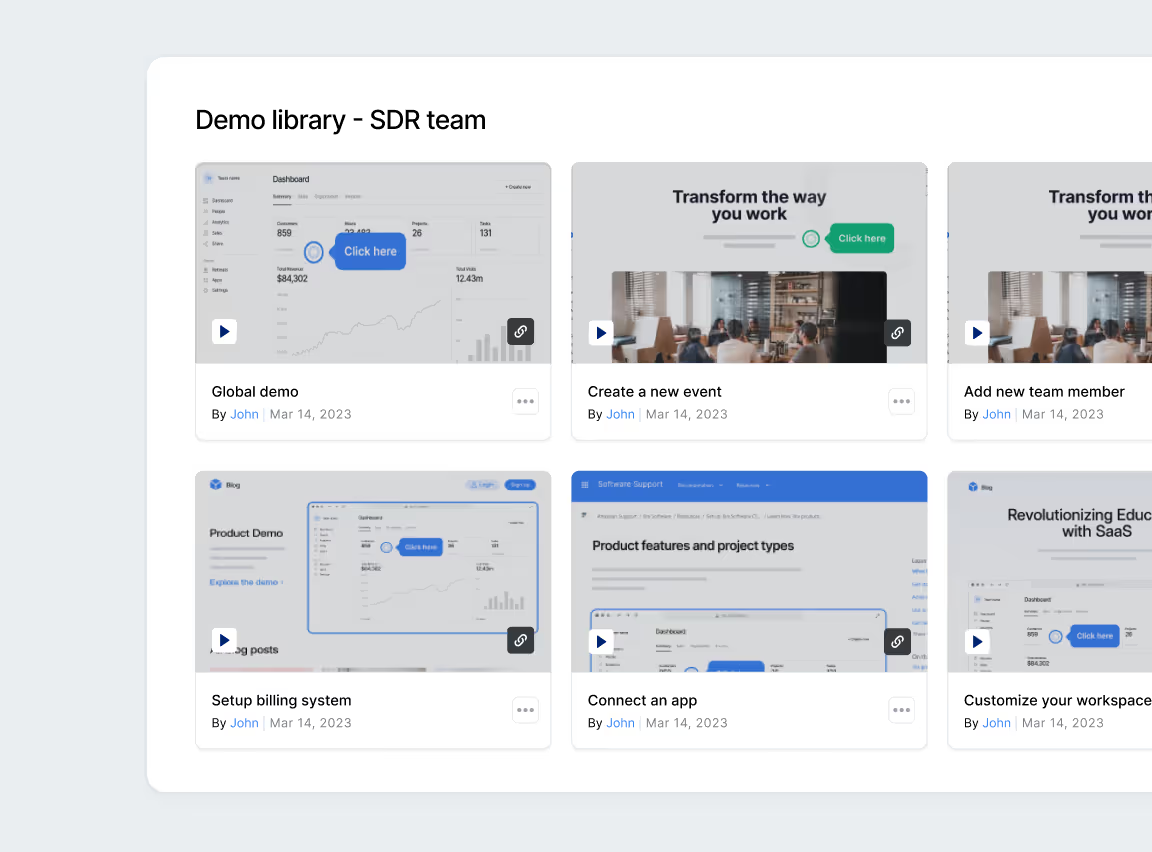
Challenge
Channel partners often lack deep product knowledge or current demonstration materials, creating inconsistent messaging that can undermine brand reputation and reduce conversion effectiveness. Partners may use outdated presentations, misrepresent capabilities, or fail to communicate differentiating value propositions effectively. This knowledge gap becomes particularly problematic as products evolve. Partners struggle to stay current with new features, updated positioning, and refined messaging strategies. The result is missed sales opportunities, customer confusion, and potential brand damage when partners provide inaccurate or incomplete information to prospects.
Solution
Demo centers provide comprehensive training resources and customer-facing tools that ensure consistent messaging across partner channels while maintaining both brand standards and partner identity. Partners receive access to current demonstration content, sales enablement materials, and training resources that keep them aligned with corporate messaging. The platform enables partners to deliver professional demonstrations using branded experiences that maintain their visual identity while showcasing products accurately. Partners can customize certain elements to reflect their market positioning while core product messaging remains consistent with corporate standards.
Continuous updates ensure partners always have access to current content reflecting the latest product capabilities, positioning strategies, and competitive responses. When new features launch or messaging evolves, all partners immediately receive updated materials without requiring individual training sessions.
Benefits
- Branded demo experiences maintain partner visual identity while showcasing products through professionally produced content that partners can confidently share with their prospects.
- Sales enablement resources including talk tracks, objection handling guides, and competitive comparison materials help partners navigate complex sales conversations effectively.
- Performance tracking identifies most active and successful partners by monitoring demonstration usage, engagement rates, and conversion patterns across the partner network.
- Certification programs ensure proper product understanding by requiring partners to complete training modules and demonstrate knowledge before gaining access to customer-facing tools.
- Partner onboarding accelerates as new partners can immediately access comprehensive product training and demonstration resources rather than waiting for scheduled training sessions.
When to use
- Channel partner programs with multiple resellers benefit from standardized resources that ensure all partners represent products consistently regardless of their size or market focus.
- New partner onboarding and training initiatives gain efficiency through self-service resources that partners can access immediately upon signing partnership agreements.
- Partner performance improvement programs can identify knowledge gaps by analyzing which demonstration content partners use most effectively and where additional training might be needed.
- Competitive differentiation training across partner networks ensures all partners can effectively articulate unique value propositions and counter competitive objections.
- Product launch coordination across distributed partner networks ensures all partners can begin selling new capabilities immediately with current, accurate information.
Use case 6: Customer expansion conversations
Challenge
Customer success managers face the delicate balance of introducing advanced features and expansion opportunities without overwhelming customers or requiring extensive one-on-one training sessions. Customers may be unaware of capabilities that could deliver significant additional value, but traditional training approaches are resource-intensive and difficult to scale.
The challenge intensifies as products evolve and expand. Customers who adopted solutions years ago may not realize how significantly capabilities have grown, missing opportunities to derive greater value from their investments. Without structured approaches to feature education, adoption remains shallow and expansion revenue opportunities go unrealized.
Solution
Demo centers enable existing customers to explore additional features, complementary solutions, and advanced use cases independently while providing customer success teams with engagement data that reveals expansion readiness. Customers can discover new capabilities at their own pace without feeling pressured by sales-focused conversations. Customer success managers create personalized exploration pathways highlighting features relevant to each customer's usage patterns and business objectives. A customer heavily using basic workflow automation might receive demonstrations of advanced integration capabilities, while another focused on reporting sees advanced analytics features.
Engagement tracking reveals which customers are actively exploring expansion opportunities, enabling customer success teams to offer timely support and guidance when interest is highest. This proactive approach converts curiosity into adoption by providing assistance at the moment customers are most receptive.
Benefits
- Advanced feature adoption programs introduce underutilized capabilities through targeted demonstrations that show specific use cases relevant to each customer's business context.
- Cross-selling initiatives demonstrate complementary product value by showing how additional solutions integrate with customers' existing implementations to deliver expanded capabilities.
- Renewal preparation reinforces product value through success stories and advanced capability demonstrations that remind customers of the platform's strategic importance to their operations.
- User training programs improve adoption and satisfaction scores by providing self-service resources that customers can access whenever questions arise rather than waiting for scheduled training sessions.
- Expansion pipeline visibility improves as customer success teams can identify which accounts are actively exploring additional capabilities, enabling more accurate revenue forecasting.
When to use
- Customer success programs focused on feature adoption benefit from self-service resources that encourage exploration without requiring extensive CSM involvement in basic training.
- Expansion revenue initiatives and upselling campaigns gain effectiveness by allowing customers to independently evaluate how additional capabilities would benefit their specific use cases.
- Renewal conversations needing value reinforcement can leverage demonstrations of recently launched features and customer success stories that validate the ongoing strategic importance of the platform.
- New user onboarding for existing customer accounts ensures additional team members can quickly get up to speed without requiring dedicated training sessions that strain customer success resources.
- Quarterly business reviews become more strategic when customers have already explored relevant advanced capabilities and arrive prepared to discuss expansion opportunities.
Use case 7: Event and trade show experiences
Challenge
Trade shows generate initial interest through booth conversations and brief demonstrations, but companies consistently struggle to maintain engagement after events conclude. Collected leads often go cold as prospects return to their normal routines and the urgency created by in-person interactions fades.
The problem stems from the disconnect between brief event interactions and the comprehensive evaluation prospects need before making purchase decisions. Booth conversations introduce concepts and generate curiosity, but prospects rarely have time for in-depth demonstrations during crowded trade show floors. Without structured follow-up that continues the conversation with relevant content, the investment in event participation fails to generate expected returns.
Solution
Demo centers extend event impact by providing comprehensive follow-up resources specifically tailored to booth visitors. Customized experiences reference topics discussed during event conversations, creating seamless continuity between in-person interactions and post-event digital engagement. During events, booth staff can provide immediate access through QR codes linking directly to event-specific demo center experiences. Prospects scan codes to access demonstrations referenced during conversations, allowing them to explore in detail when they have time after returning from the event.
Post-event follow-up campaigns direct attendees to personalized demonstration pathways based on their expressed interests during booth conversations. Someone who asked about integrations receives content focused on API capabilities and integration use cases, while another interested in compliance sees security and regulatory content.
Benefits
- QR codes linking directly to event-specific demo center experiences enable immediate value delivery during booth conversations, allowing prospects to save content for later review rather than trying to absorb everything during brief interactions.
- Follow-up campaigns with access to demonstration content referenced during conversations create strong continuity between event interactions and post-event engagement, maintaining momentum generated during face-to-face meetings
- Lead qualification processes identify most interested event attendees by tracking which prospects actively explore demonstrations after the event versus those who simply collected marketing materials.
- ROI measurement tracking conversion rates from event leads through demo interactions provides clear visibility into which trade shows and events generate the highest quality opportunities.
- Sales follow-up effectiveness improves as account executives can reference specific demonstrations prospects have already viewed, creating informed conversations rather than starting from scratch.
When to use
- Major industry conferences and trade shows with high attendee volumes benefit from scalable follow-up approaches that provide personalized experiences without requiring individual attention for every lead.
- User conferences and customer events can showcase new capabilities and expansion opportunities through structured demonstration experiences that customers can explore at their convenience.
- Partner events and channel programs enable partners to continue conversations with prospects they meet at regional or vertical-focused events using corporate-provided demonstration resources.
- Webinar follow-up and virtual event experiences extend engagement by allowing attendees to explore topics covered in presentations more deeply through interactive demonstrations.
- Sponsored event activations gain higher ROI when sponsorship includes demo center access that extends brand exposure and engagement beyond the event itself.
Use case 8: Outbound prospecting acceleration
Challenge
Cold outreach that immediately requests prospect time for discovery calls receives predictably low response rates. Busy executives and decision-makers are reluctant to commit 30-60 minutes to exploratory conversations with unfamiliar vendors. Simultaneously, generic demonstration content fails to address the specific needs and priorities of individual prospects, resulting in disengagement even when initial interest exists. Sales development representatives face the difficult task of creating enough value in brief outreach messages to warrant prospect attention while having limited information about specific pain points and priorities. Traditional approaches force a choice between providing no demonstration content and risking dismissal as another generic vendor, or sending lengthy videos that prospects won't watch.
Solution
Demo centers enable SDRs to offer immediate value through relevant demonstration content without requiring scheduled meetings. Outreach messages can provide instant access to demonstrations addressing common challenges in the prospect's industry or role, building interest while qualifying their needs organically. SDRs create personalized demonstration pathways based on prospect research, company data, and role-specific priorities. A message to a CFO includes financial reporting, forecasting, and compliance demonstrations, while outreach to an operations leader features workflow automation and efficiency optimization content.
Engagement tracking reveals which prospects genuinely investigate the solution versus those who politely acknowledge the outreach but have no real interest. SDRs can focus follow-up efforts on prospects who explored multiple demonstrations or spent significant time evaluating specific capabilities.
Benefits
- Higher response rates result from outreach offering immediate value rather than requesting time, as prospects can evaluate relevance on their schedule without commitment.
- Better qualified opportunities get passed to account executives with clear prospect interest data showing which capabilities attracted attention and how thoroughly they evaluated the solution.
- Scalable personalization based on prospect company and role characteristics enables SDRs to create tailored experiences without requiring individual customization for every outreach message.
- Engagement tracking identifies genuinely interested prospects versus polite responses by revealing who actually explored content versus who simply acknowledged receipt.
- Faster pipeline development occurs as prospects can quickly determine solution fit through self-service evaluation rather than waiting for scheduled discovery calls to assess basic relevance.
When to use
- Cold outreach campaigns to new prospect segments benefit from low-commitment entry points that allow prospects to evaluate relevance before investing time in conversations.
- Account-based marketing initiatives targeting specific companies can create highly customized demonstration experiences incorporating company-specific use cases and relevant customer success stories.
- Territory expansion efforts in new geographic markets provide localized demonstration content addressing region-specific requirements and featuring relevant customer examples.
- Competitive displacement campaigns against incumbent solutions can systematically address switching considerations through demonstrations showing migration paths, comparative advantages, and implementation approaches.
- Multi-threaded account development enables SDRs to simultaneously engage multiple stakeholders within target accounts by providing role-specific demonstration content to each person.
Key features of Guideflow demo centers
Curated demo playlists and segment-based personalization
Group demos and videos by product, persona, or use case within organized demo centers. Show relevant content to different audiences based on visitor data, enabling targeted experiences that resonate with specific stakeholder needs while eliminating generic demonstrations.
Benefits
- Improves demo relevance for different buyer personas and company sizes
- Streamlines demonstration selection and deployment across sales teams
- Enables targeted messaging without creating multiple demo versions
- Increases stakeholder engagement through contextual, role-specific content delivery
Self-guided exploration with adaptive journeys
Allow visitors to freely explore demonstrations and choose content matching their interests, roles, or pain points. Buyers control their evaluation journey while smart routing technology presents relevant next steps based on engagement patterns.
Benefits
- Creates authentic buyer experiences mirroring natural evaluation processes
- Enables autonomous prospect education without presales scheduling dependencies
- Reduces cognitive load through intuitive navigation and logical content progression
- Builds buyer confidence through comprehensive product understanding at their own pace
Real-time visitor insights and behavioral analytics
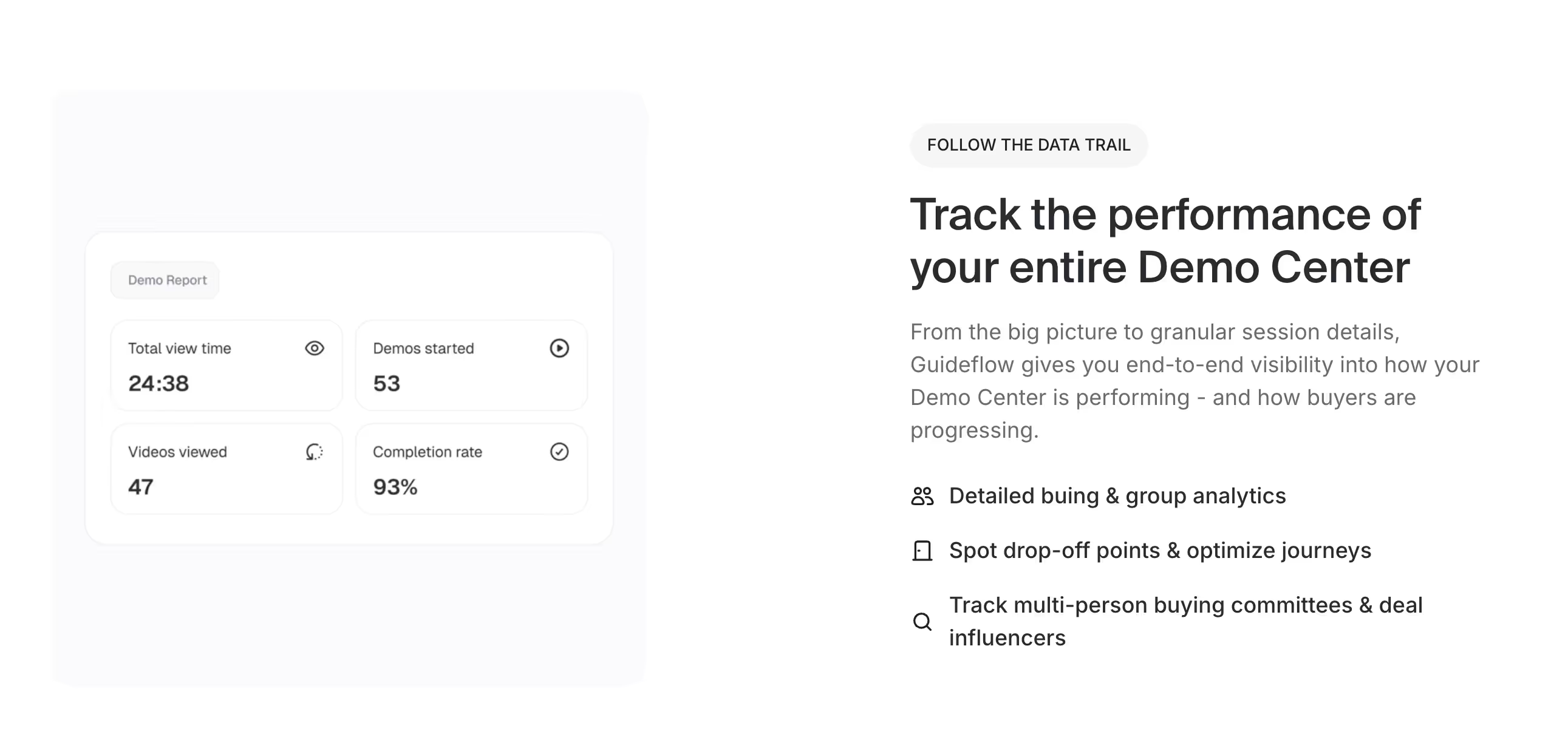
Track who's engaging, what they're viewing, and for how long with comprehensive analytics including completion rates, drop-off analysis, visitor identity tracking, and intent scoring.
Benefits
- Provides actionable insights for sales follow-up prioritization and resource allocation
- Enables continuous optimization based on engagement patterns and conversion data
- Identifies high-intent prospects through behavioral analytics and engagement depth
- Improves qualification accuracy through data-driven lead scoring and automatic alerts
Centralized content management and control
Organize all buying assets into one guided experience through drag-and-drop editors that combine demos, videos, PDFs, case studies, and interactive content into seamless buyer journeys.
Benefits
- Eliminates content fragmentation and version control issues across sales teams
- Reduces administrative overhead through centralized asset management and updates
- Ensures consistent product narratives and brand messaging across all demonstrations
- Enables rapid content deployment and updates without technical dependencies
Advanced personalization and dynamic customization
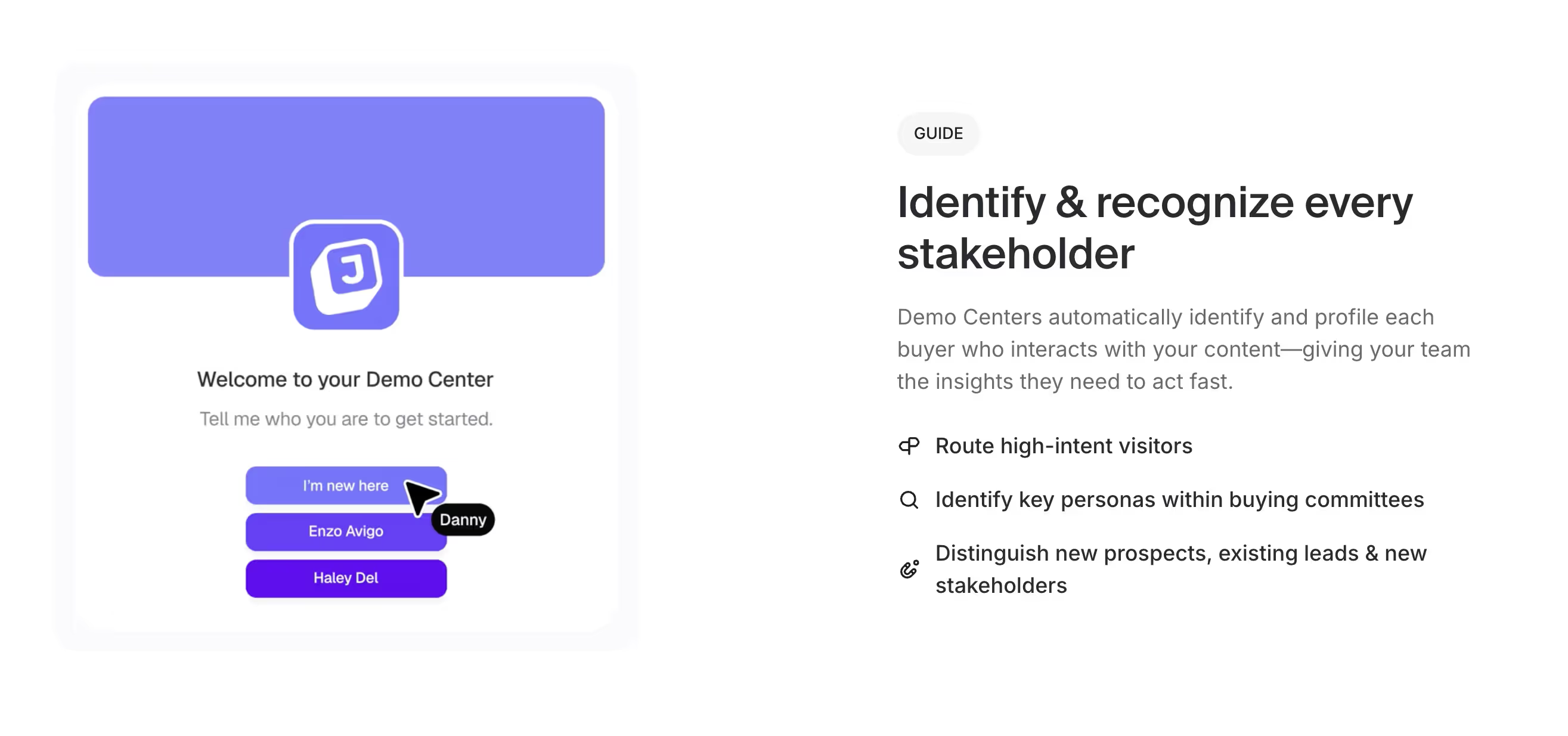
Personalize demonstrations to every prospect by customizing text, images, data, and embedded content in real time to match individual company needs while maintaining data security.
Benefits
- Increases relevance and engagement through prospect-specific demonstrations and scenarios
- Accelerates demonstration customization without manual effort or technical resources
- Maintains data security while enabling realistic business scenarios and use cases
- Scales personalization across large prospect volumes without individual sales team attention
Custom branding and visual identity
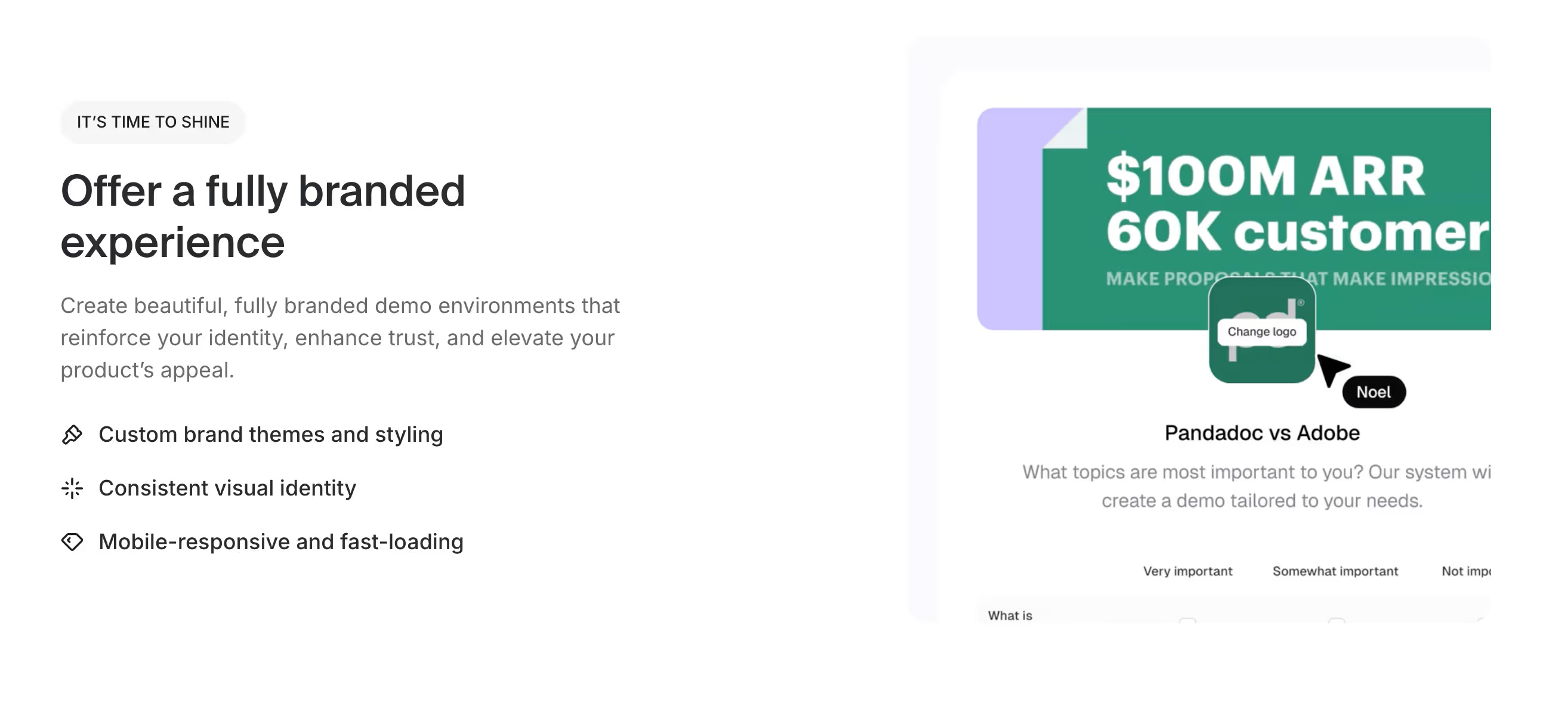
Create fully branded demo environments that reinforce your identity, enhance trust, and elevate your product's appeal through advanced theming capabilities ensuring consistent visual identity.
Benefits
- Strengthens brand recognition and professional credibility during buyer evaluation
- Enhances buyer trust through polished, consistent visual experiences
- Supports marketing objectives through cohesive brand presentation across all touchpoints
- Improves conversion rates through professional demonstration delivery and visual appeal
Seamless sharing and distribution capabilities
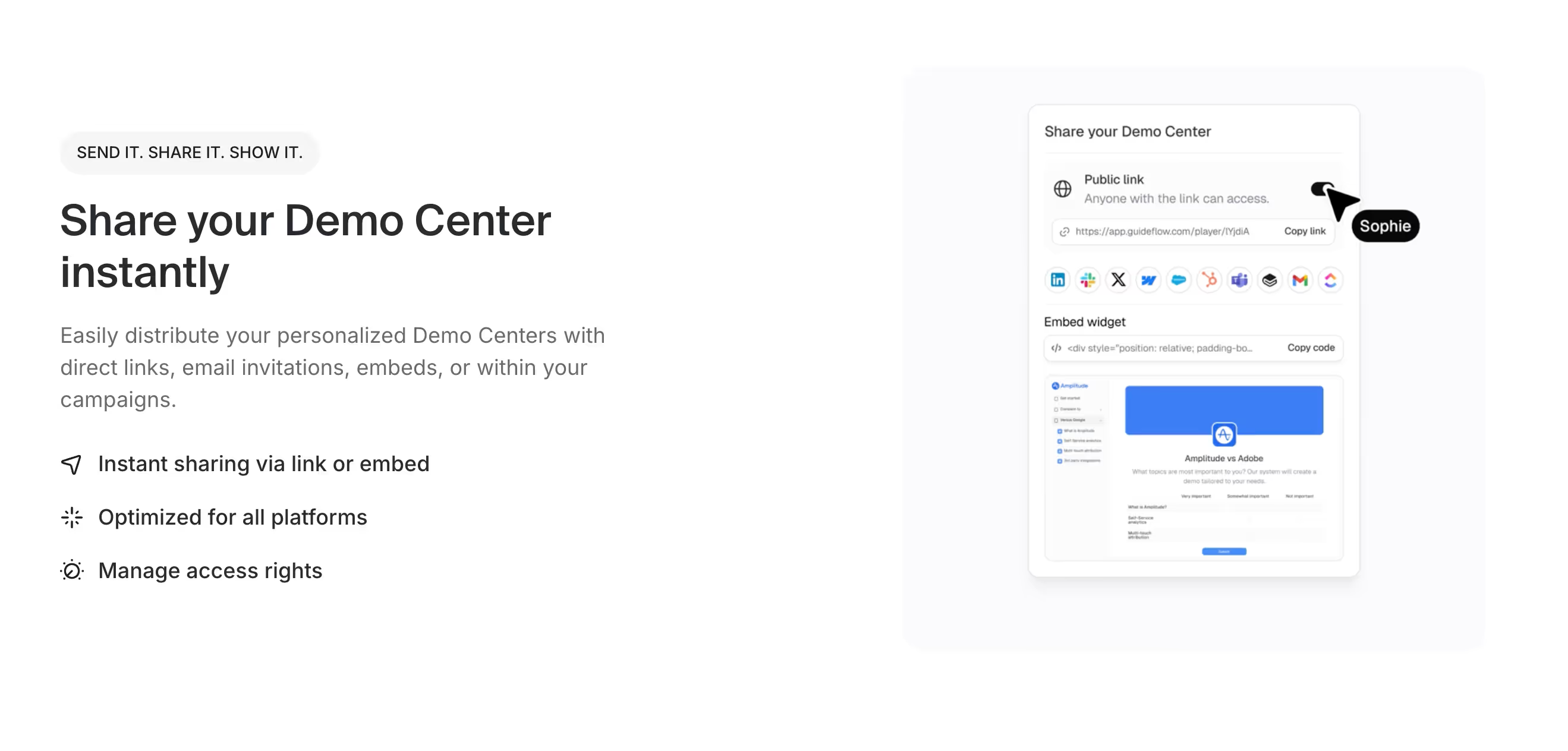
Distribute demo centers easily via shareable links, email invitations, embedded widgets, or campaign integration with advanced access controls enabling both public and private sharing.
Benefits:
- Enables flexible deployment across multiple channels and marketing campaigns
- Maintains control over demonstration access and audience targeting requirements
- Supports both self-service and guided demonstration approaches for different scenarios
- Ensures consistent messaging and experience delivery across all distribution methods
Comprehensive CRM and marketing automation integration
Works seamlessly with HubSpot, Salesforce, Marketo, and other essential go-to-market tools through integration capabilities including automatic lead scoring, CRM sync, workflow automation, and real-time alerts.
Benefits:
- Streamlines lead management and sales processes through automated data flow
- Automates prospect prioritization and follow-up timing based on engagement patterns
- Reduces manual data entry and administrative overhead for sales teams
- Improves sales team efficiency and response times through intelligent automation and alerts
Implementation best practices
Content organization strategies
Start with audience segmentation rather than product feature organization. Create primary navigation paths based on job roles, company sizes, and industry verticals rather than technical product categories.
Develop content hierarchies guiding prospects from high-level overviews to detailed technical demonstrations. Each demo should include clear next steps encouraging deeper engagement with relevant content.
Create modular content libraries that combine into different demonstration experiences. Individual demo components should work independently while supporting larger narrative flows about business outcomes.
Personalization setup
Implement progressive personalization becoming more sophisticated over time. Start with basic segmentation using company data and geographic information, then add behavioral tracking and engagement-based customization.
Connect CRM integration early to ensure visitor data flows into existing sales and marketing processes. Proper integration enables automatic lead scoring, sales alert generation, and marketing automation triggers.
Design role-based content paths presenting information appropriate to different job functions and seniority levels. Technical stakeholders need implementation details while executives want business outcome data.
Integration recommendations
Prioritize marketing automation platform connections to enable sophisticated follow-up campaigns based on demonstration engagement. Prospects viewing security-focused demos should receive security-related nurture content.
Establish sales team workflows leveraging demo center data for qualification and follow-up processes. Account executives should receive alerts when prospects engage with high-intent demonstration content.
Create customer success integration points helping identify expansion opportunities and feature adoption patterns. Existing customers exploring advanced demonstration content signal potential upselling opportunities.
Success measurement frameworks
Define engagement quality metrics beyond basic page views and time-on-site measurements. Track demonstration completion rates, return visit frequency, and content depth exploration.
Monitor conversion impact across multiple touchpoints to understand how demo center engagement influences overall sales and marketing performance.
Establish baseline measurements before demo center deployment to quantify improvements accurately. Track current conversion rates, lead qualification efficiency, and sales team productivity.
Create feedback loops with sales and customer success teams to identify content gaps and optimization opportunities through regular review sessions.
Getting started
Begin by auditing your current demonstration content to identify scattered assets and inconsistent experiences across your buyer journey. This assessment reveals where prospects encounter friction or confusion as they evaluate your solution. Next, map your complete buyer journey to understand how different stakeholder types interact with your product information. This mapping exercise highlights demonstration gaps that create obstacles for technical evaluators, business decision-makers, and executive sponsors at different stages of their evaluation process.
Once you understand these gaps, start with a focused pilot program targeting your highest-value use cases and most important prospect segments. This concentrated approach delivers measurable impact quickly while allowing you to refine your methodology before broader rollout. Throughout implementation, measure results systematically to quantify improvements in lead quality, conversion rates, and sales team efficiency. These metrics demonstrate ROI and guide continuous optimization of your demo center strategy.
Modern demo center platforms enable rapid deployment with drag-and-drop content creation, seamless CRM integration, and sophisticated analytics providing immediate visibility into buyer engagement patterns. Implementation typically takes 2-4 weeks rather than months, making this a practical solution for immediate go-to-market improvement. The question isn't whether demo centers will become standard practice in B2B SaaS. The question is whether your organization will lead this transition or follow competitors who recognize the strategic value of buyer-centric demonstration experiences.
Related posts
Learn more about Guideflow, our approach to authentication, and company news.



